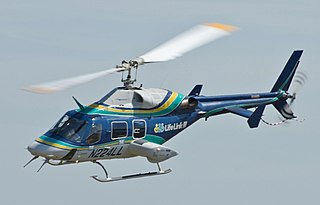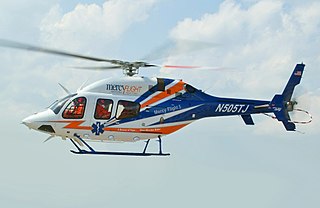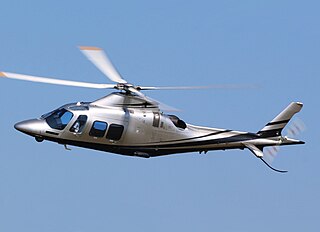
The AgustaWestland AW109, originally the Agusta A109, is a lightweight, twin-engine, eight-seat multi-purpose helicopter designed and initially produced by the Italian rotorcraft manufacturer Agusta. It was the first all-Italian helicopter to be mass-produced. Its production has been continued by Agusta's successor companies, presently Leonardo.

The Bell 222 is an American twin-engine light helicopter built by Bell Helicopter. The Bell 230 is an improved development with different engines and other minor changes.

The Bell 206 is a family of two-bladed, single- and twin-engined helicopters, manufactured by Bell Helicopter at its Mirabel, Quebec, plant. Originally developed as the Bell YOH-4 for the United States Army's Light Observation Helicopter program, it was not selected by the Army. Bell redesigned the airframe and successfully marketed the aircraft commercially as the five-place Bell 206A JetRanger. The new design was eventually selected by the Army as the OH-58 Kiowa.

The PZL SW-4 Puszczyk is a Polish light single-engine multipurpose helicopter manufactured by PZL-Świdnik. Following a protracted development, the SW-4 entered service in 2002, the primary operator of the type has been the Polish Armed Forces. The SW-4 was further developed by PZL-Świdnik and corporate parent AgustaWestland into an optionally piloted vehicle, the SW-4 Solo. From 2016 onwards, the type has been marketed to civil operators as the AW009, while the SW-4 designation is used for the military market.

The Bell 407 is a four-blade, single-engine, civil utility helicopter. A derivative of the Bell 206L-4 LongRanger, the 407 uses the four-blade, soft-in-plane design rotor with composite hub developed for the United States Army's OH-58D Kiowa Warrior instead of the two-blade, semi-rigid, teetering rotor of the 206L-4.

The Sikorsky S-92 is an American twin-engine medium-lift helicopter built by Sikorsky Aircraft for the civil and military helicopter markets. The S-92 was developed from the Sikorsky S-70 helicopter and has similar parts such as flight control and rotor systems.

The Messerschmitt-Bölkow-Blohm Bo 105 is a light, twin-engine, multi-purpose helicopter developed by Bölkow of Ottobrunn, West Germany. It was the first light twin-engine helicopter in the world, and the first rotorcraft that could perform aerobatic maneuvers such as inverted loops. The Bo 105 features a hingeless rotor system, a pioneering innovation in helicopters when it was introduced into service in 1970. Production of the Bo 105 began at the then-recently merged Messerschmitt-Bölkow-Blohm.

The Bell 429 GlobalRanger is a light, twin-engine helicopter developed by Bell Helicopter and Korea Aerospace Industries. The first flight of the prototype took place on February 27, 2007, and the aircraft received type certification on July 1, 2009. The Bell 429 is capable of single-pilot IFR and Runway Category A operations.

The Bell 214 is a medium-lift helicopter derived from Bell Helicopter's ubiquitous UH-1 Huey series. The Bell 214ST shares the same model number, but is a larger, much-modified twin-engine derivative.

The MD Helicopters MD 500 series is an American family of light utility civilian and military helicopters. The MD 500 was developed from the Hughes 500, a civilian version of the US Army's OH-6A Cayuse/Loach. The series currently includes the MD 500E, MD 520N, and MD 530F.

The MD Helicopters MD 600N is a light utility civilian helicopter designed in the United States. It is a stretched eight-seat development of the five-seat MD 520N helicopter.

The Schweizer 330 and S333 are turbine-powered developments of the Schweizer 300 light piston-powered helicopter. As of 2007, only the Schweizer 333 remains in production. In February 2009, the 333 was rebranded as the Sikorsky S-333. In 2018 the Schweizer R.S.G. bought the Schweizer Aircraft from Sikorsky Aircraft and it was rebranded as Schweizer S333 again.

The EurocopterAS355 Écureuil 2 is a twin-engine light utility helicopter developed and originally manufactured by Aérospatiale in France.

The Bell 204 and 205 are the civilian versions of the UH-1 Iroquois single-engine military helicopter of the Huey family of helicopters. They are type-certificated in the transport category and are used in a wide variety of applications, including crop dusting, cargo lifting, Forestry Operations, and aerial firefighting.

The Eurocopter EC635 is a multi-purpose light helicopter developed by Eurocopter as a military version of the Eurocopter EC135. It is a twin-engined aircraft and can carry up to 8 people, including the pilot, and a range of military equipment or armaments. The helicopter is marketed for troop transport, medical evacuation, cargo transport, reconnaissance and surveillance and armed combat support missions.

The Bell 400 TwinRanger was a prototype four-bladed, twin-engine civil helicopter developed by Bell Helicopter in the 1980s. Both the TwinRanger and another planned version, the Bell 440, were attempts to market a twin-engine development of the Model 206L LongRanger. The Bell 400A was a planned single-engine version of the 400. TwinRanger, however development was canceled when Bell could not acquire enough orders for production. The TwinRanger name was later used for a twin-engine version of the LongRanger produced from 1994 to 1997.

The Bell 214ST is a medium-lift, twin-engine helicopter descended from Bell Helicopter's ubiquitous UH-1 Huey series. Though it shares a type number with the somewhat-related Bell 214, the 214ST is larger and of quite different appearance.

The Enstrom 480 is a small, light helicopter produced by the Enstrom Helicopter Corporation.

The Bell 47J Ranger is an American single-engine single-rotor light helicopter manufactured by Bell Helicopter. It was an executive variant of the highly successful Bell 47 and was the first helicopter to carry a United States president.

The AgustaWestland AW109S Grand is a lightweight, twin-engine, eight-seat multi-purpose helicopter built by the Italian manufacturer AgustaWestland. This rotorcraft has been developed from AgustaWestland AW109 by lengthening the cabin and main rotor blades with different tip design. The Agusta Grand is fitted with two Pratt & Whitney Canada PW207C engines whereas its predecessor AW109E has two Pratt & Whitney Canada PW206C engines. It originally entered service in 2005 and has since been used in various roles, including light transport, medevac, search-and-rescue, and military roles.





















